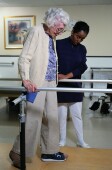
THURSDAY, Dec. 15 (HealthDay News) — Using a robotic assist system along with conventional rehabilitation therapy boosts the walking ability of people who’ve suffered a severe stroke, Italian researchers say.
They tracked 48 stroke survivors who were unable to walk at the start of the study. Half of the patients underwent conventional gait rehabilitation and half had conventional rehab plus robotic-assisted gait training for several months.
The robotic devices are therapist-controlled electromechanical platforms attached to the patient’s feet. The therapist assesses the patient’s status and then progressively sets the walking pace and bearing weight.
The patients’ mobility was evaluated while in hospital, at discharge and then again two years later.
Among the patients in the robotic device-assisted group, only those with the greatest degree of disability showed improvement, according to the study published in the Dec. 15 issue of the journal Stroke.
“After two years, five times more patients who underwent robotic assistance training were able to walk without assistance, but only the most severely impaired,” lead researcher Dr. Giovanni Morone, a physiatrist specialist and temporary assistant professor at the Santa Lucia Foundation, Institute for Research Hospitalization and Health Care in Rome, said in a journal news release.
“In others it seemed to make little difference, so the patient selection for this type of treatment is most important,” he noted.
Some studies have found that robotic assistance can help improve stroke patients’ mobility for six months, while others have found that it’s equal to or less effective than having patients walk outside, the researchers pointed out in the news release.
“It could be time to change the research question from whether or not robotic-assisted walking training is effective, to who will benefit the most,” Morone said. “Doctors need to select the right patients and remember that this is an adjunct [added] to traditional gait training.”
One U.S. expert agreed that the role of robotics in stroke recovery remains unclear.
“While exciting, there is still much work to be done in establishing the effectiveness of robotics,” said Dr. Craig Rosenberg, chairman of the department of rehabilitation medicine, at North Shore-LIJ Southside Hospital in Bay Shore, NY. “The cost of robotics remains high and there is limited availability to the stroke- and brain-injured population,” he added.
Rosenberg also noted that “robotic technology is typically available only through research studies at this time.”
More information
The National Stroke Association has more about stroke recovery and rehabilitation.

